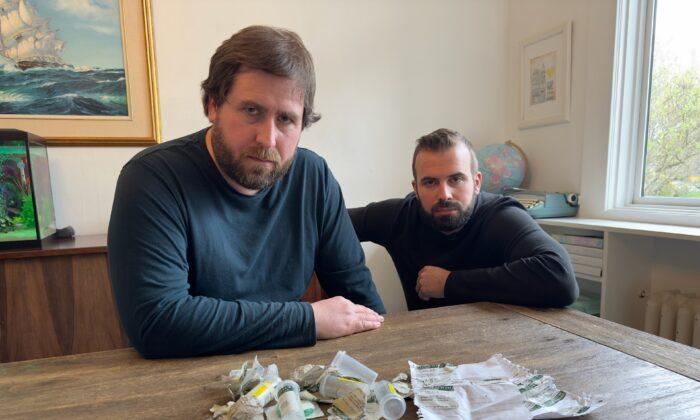With its “safer supply” approach to addiction, Canada’s federal government is giving out large amounts of hydromorphone—a drug that’s too mild to satisfy many addicts but powerful enough to attract the new drug-users getting ahold of it, says documentary filmmaker Aaron Gunn.
Each addict can receive dozens of pills daily, and many of them sell the hydromorphone to buy fentanyl, says Gunn, whose recently released film, “Canada Is Dying,” looks at the effects of “safer supply.” It’s often kids who are buying the hydromorphone, Gunn said.
“These drugs are being diverted back to high schools, back to college campuses, back to university campuses,” Gunn told The Epoch Times. “The federal government is literally flooding Canadian streets and the campuses of Canadian schools with cheap, powerful, dangerous, and addictive opioids.”
He said it’s similar to the flood of OxyContin that started the opioid addiction crisis more than a decade ago. “Except this time, we’re doing it with even more powerful drugs,” he said.
Doctors, law enforcement, addicts, pharmacists, and others all expressed their concerns to Gunn.
Addiction clinic workers told him that a few years ago they never saw hydromorphone addictions. But since the ramp-up of safer supply initiatives, about half their new patients are hydromorphone addicts. “Most of them very, very young, as young as 13 or 14 years old,” Gunn said.
Overdoses
Proponents of safer supply, including Prime Minister Justin Trudeau, say it prevents overdose deaths by giving addicts an alternative to riskier street drugs. They say it destigmatizes drug-use, encouraging people to seek treatment. They say it removes the need for risky behaviours associated with obtaining drugs, such as sex work, theft, and transactions with criminals.A Health Canada spokesperson told The Epoch Times via email that the statistic comes from information submitted to the ministry on overdoses prevented at the sites per month and could not give much further detail.
Proponents of safer supply often say that it’s “evidence-based” and emphasize that the science supports it.
From Nanaimo to London
Gunn zoomed in on cities like Nanaimo, B.C., which has had its residents dying at twice the provincial rate from drug toxicity this year, and London, Ont., where safer supply has been prominent and so has a rise in drug-use and overdoses.Hydromorphone labels littered the ground outside a safer supply pharmacy Gunn went to in Nanaimo. Patients with prescriptions for the pills peel off the labels as they sell the drugs to others on the street.
Later in the report, however, the challenges are listed, including “diversion (such as participants selling, trading or giving their prescribed medications to someone else).” The “top challenge” listed is that people continue to use fentanyl because hydromorphone doesn’t provide a strong enough high. One of the main goals of the pilots was to provide alternatives to such toxic illegal drugs.
In London, Gunn talked to Dr. Sharon Koivu, an addiction physician with the London Health Sciences Centre (LHSC). She has seen first-hand how safer supply has played out, with London starting its initiatives early, in 2012. Initially, she said, it was to prevent sex workers from having to sell their bodies to get drugs. But she said it has caused bigger problems.
“We are giving out huge amounts of a very highly addictive, very dangerous opioid narcotic,” Koivu said. She gave the example of a patient who has a prescription from her doctor for 40 tablets daily even though her treatment program has her scheduled to only take 9 tablets per day. She’s likely selling the other 31, Koivu said.
A B.C. pharmacist who wished to remain anonymous told Gunn that during an average shift, her pharmacy gives out 1,000 pills or more. Many of them are sold on the street, and even the ones used by addicts are often used improperly and unsafely, she said, such as by injection instead of ingestion.
Gunn praised Alberta’s more recovery-focused approach to addiction. He interviewed the premier’s chief of staff and former addict, Marshall Smith, who said reducing stigma isn’t an effective approach.
Smith said many addicts have little concern for the stigma around drug use. He said anti-smoking campaigns show us what works when it comes to addiction. With those, it’s clear that smoking is wrong, people should quit it, and the government offers free help to quit.
“Safe supply is a marketing term, it’s not a medical term,” Smith said. “It’s a term that was made in a boardroom with communications experts and advocates, and it’s made to communicate to people the feeling of safety. It’s not safe.”






Friends Read Free